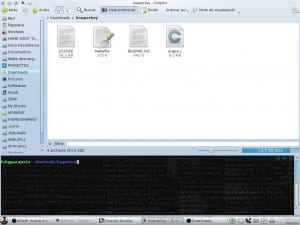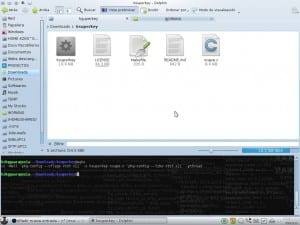One of the habits that we have when we exit Windows is to open or close the "start menu" (referring to that menu or button through which we access the installed applications) using only the Windows key, that is, that key with the Windows logo that always reminds us that our computer had Windows installed once hahaha.
En KDE By default to open or close this menu, it is with the combination [Alt] + [F1], and it can be changed yes, but it cannot be set with ONE key, we cannot specify that only by pressing [win] we already want it to be shown.
Well… in Linux, I think few things are impossible, and this is not one of them 😀
Thanks to mogger We can now open or close this menu just by pressing [win] ... here I show you how 😀
1. First download this compressed file, and unzip it (NOTE!!, now they have a .DEB for install!):
2. Once you unzip it, access the ksuperkey folder that appeared.
3. Once inside, press [F4] to open a terminal there, I leave a screenshot:
4. Through that terminal install the package called pkg-config and those necessary to compile ... in distros like Debian or derivatives, it is enough with:
sudo apt-get install pkg-config gcc make libx11-dev libxtst-dev
5. Once installed, we write make And we pressed [enter], I show you a screenshot:
6. Execute that file, either by double clicking on it, or by putting in the terminal ./ksuperkey
Done ... now press [win] 😀
If it doesn't work for you, right click on the start menu button, select «Application launcher preferences«, And check the quick access they have on.
This trick will stop working when they close the session, that is why they must configure that program (ksuperkey) is always started when you log in.
To do this, open the KDE Control Panel, where it says «Startup and shutdown«, There they add a new script at the beginning, and the script to add will be this one ... ksuperkey
Well nothing more to add 😀
I pleased with this hahahahaha.
regards
PD: If you don't want this tip working, just don't run the program and that's it 😉



Well, I think it's good for those who have 'Windowscitis', because the 'meta' key gives much more than that in terms of keyboard shortcuts. I use it for almost everything, to show Amarok, rate the songs, make a quick post in Choqok without the need for it being displayed on the screen, show the tasks of the current desktop, tasks of the same class, tasks of all the desktops, show the grid, etc etc etc. As I said, for those who are nostalgic, but would be wasting KDE and its extreme customization possibilities 🙂
well if it does not affect the other combinations my comment has no validity 😉
In fact, it doesn't bother you at all!
Actually no, because as far as I remember there is no function for the superkey alone, unless you create a script like this and assign it to it.
Even when I tried to use KDE (in chakra, cool distro, by the way) the most "comfortable" thing I could make the menu open by shortcut was super + z, since even in KDE 4.9 it was not possible to choose a function for only that key.
You can open the start menu with the Windows (Super) key on the right without ksuperkey. You just have to configure a couple of things. Some of you blame KDE for shortcomings that don't exist.
Gara, you could use a better font smoothing ahahah, the fonts you're wearing look horrible.
Yes? ... mmm they don't seem horrible to me hahaha
+11000
But nothing, it's KZKG ^ Gaara, it usually goes against the world xDD
What distro is the one in the photo?
Lesbian, if I'm not mistaken.
Debian Testing + KDE (4.8.4) 😉
It didn't work for me when I did Make… Error…
What error did he give you? Did you follow kazaa's instructions !?
Just in case, check the README.md file that brings the list of dependencies necessary to compile the application.
If you don't get to walk for any reason, I can pass you the already compiled file 😉
as a preliminary step to ensure we must do the following
sudo apt-get install gcc make libx11-dev libxtst-dev
Yep, I forgot to mention it in the post, I already edited it and added this 😀
Also ... they added a .DEB to install this app, and I also added the link to it 😉
http://maaaks.ru/chaos/ksuperkey/ksuperkey_0.1-2_i386.deb
Put in our paste (http://paste.desdelinux.net) the error log, to try to fix it.
Right now I just saw that they already added a .deb - » http://maaaks.ru/chaos/ksuperkey/ksuperkey_0.1-2_i386.deb
But this is a pearl dear, where did you get it? Gross !!!
+1 and enjoying ksuperkey!
HAHAHAHAHA I found her in KDE-App hahahaha, yes she is a pearl 😀
Isn't there a way to have it in Fedora 17?
If you install the following packages and do the make, it should work:
pkg-config gcc make libx11-dev libxtst-dev
Very good!!!! question: I lose the key combinations with the «Super» key? (example, super + d shows me the desktop according to my configuration ...)
another question. Why is my ubuntu logo the old one and others see the new one? I mean, I run 12.04… 😛
Is it because it is 32 bit?
I use it on a 64
then it will be the browser version
mmm I think it's because you don't specify the Ubuntu version in your UserAgent, I'll have to make a little fix in the comment plugin 😀
I use Super + d to open dolphin and I can continue doing it after this tip, so no, you don't lose the settings 😉
How do you open Dolphin with that combination? Thank you!
The problem with ksuperkey is that it hijacks the Alt + F1 combination and is not necessary. You can use the Windows key on the right to launch the Start menu and the Windows key on the left as a Meta key without ksuperkey.
Ah look hahahaha, I thought so 😀
Yep, I think you would. It's a matter of trying, and if you don't like the result, leave the session and go back in, and you're done as before 😀
I think what this little program does is fool the system, and tell it that [Win] = [Alt] + [F1]
Thanks for the tip. I've been looking for something like that for a long time. Specifically, since I stopped using KDE 3 (previously this could be done from "system preferences").
Thank you!
hahaha yes, in KDE3 you could put the keyboard just like in Windows (I mean shortcuts).
I leave you a link with an alternative method (without installing anything):
http://masquepeces.com/windousico/2012/08/asignar-teclas-de-acceso-rapido-en-kde/
The trick is at the end of the article.
Fuck, that was the option that I used xD
Thank you
I followed all the steps but it doesn't work for me. D:
What distro do you use?
If you use .DEB package and you use 32bits, here is a .DEB that they did: http://maaaks.ru/chaos/ksuperkey/ksuperkey_0.1-2_i386.deb
Anyway, tell us what error gives you to help you 😀
Ready that's it, compiled it and there it was perfect. : D.
Thank you.
hehehe nice
that's the method that I use 🙂
.DEB 64 Bits for when?
No idea 🙁
Technique, in my opinion simpler:
1-Go to System Preferences / Input Devices / Keyboard and select Advanced, in the Behavior section of the Alt / Windows key we select Meta is mapped to the left Windows key.
2-Now we open with the right button the kde menu of the panel, application launcher preferences and Quick access to keyboard and press and activate with the right windows key. We will already have this key configured (right Windows) to open and close the menu.
If we want to use the left windows key in the same way with the same objective, what we do is assign the right one to the left one (saying that they are the same key).
We open the xev program in the console, we press the left windows key and we look at where it says keycode and we write it down (it is usually 133), we do the same with the right windows and in this case we look at it (keysym 0xffec, Super_R) In this case we write down "Super_R" which will be the name of the right Windows key, and now we only have to assign one to another.
We create the .xmodmaprc file in / home / your_user / and write keycode (left Windows keycode) = (right Windows keysym). In my case keycode 133 = Super_R.
Finally we create the file "kickoff-meta.sh" and we follow the steps exactly as the post says to introduce it in the autostart folder and have it start automatically. By the way in my case the folder ~ / .kde / autostart / is ~ / .kde / Autostart /
Greetings I hope it serves you!
PS: I don't know if you will like it more or less, but that way we don't invent a key! 😛 hehe
ksuperkey
http://kde-apps.org/content/show.php?content=154569
https://github.com/hanschen/ksuperkey
In most of the distros that provide KDE, if not all, ksuperkey is one more package that does not need compilation, just install through the package manager and enjoy.
A colleague of mine did it by clicking on Preferences / Input Devices / Advanced and from there to there he does not remember why I came across this article. However, look to see if messing around you give foot with ball and tell me.
Well in the end I had to download the tar.gz compile and run. All good.
Let's see if it works
To do this open the KDE Control Panel, where it says "Startup and shutdown", there add a new script at the beginning, and the script to add will be this one ... ksuperkey
this part does not save me changes, when rebooting the ksuperkey does not load me ...
Hi. This is easier. http://blueleaflinux.blogspot.com.ar/2011/08/abrir-el-menu-de-kde-con-la-tecla.html
It's certainly a good trick, however I don't know if it's just me, but it doesn't work as expected, I press the windows key and the menu opens and closes immediately, even so, a very good note.